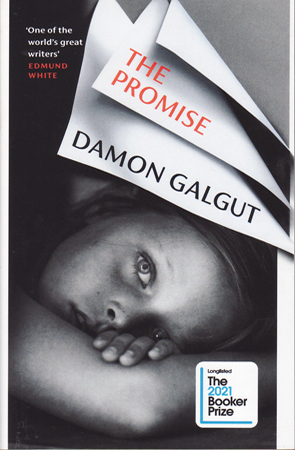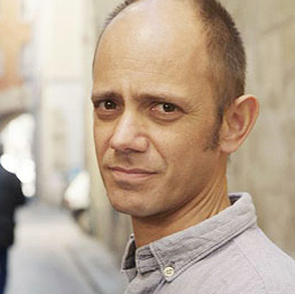The promise referred to by Damon Galgut’s title, is one made to Salome, a black woman who has worked most of her life serving a South African farming family, the Swarts. As Rachael Swart lays dying – she has been ill for months and her death is not unexpected – she makes a promise to Salome that she will bequeath the house Salome has been living in, which is on the Swart land. Salome has been ever-faithful and has nursed Rachel in her sickness. The house is in poor condition and it’s worth nothing to the family, but it means everything to Salome. The Swarts, while not bad people, are nevertheless driven by greed and self-interest. Amor, Rachel’s youngest daughter, knows of the promise, and when her mother dies she tries to hold her father, Manie, to it. But Manie is reluctant to honour his dead wife’s word – in fact he doubts it to be true – and in a moment of miscommunication, Amor comes to believe he has affirmed the promise, only to later break it. It’s a moment that will shape Amor’s future relationships with her family.
The Promise is one of the most interesting books I’ve read for a while. The plot is uncomplicated and the narrative is deceptively simple. The breaking of the promise is like a curse that hangs over the family for years. The story is told in four parts, each centred on the death of a family member, roughly a decade apart, each with an aspect of South Africa’s history playing as a backdrop to the family drama. It’s the story of an increasingly diminished family, itself changing over time, away from the traditional white farmers of the nation’s Apartheid era, as each character begins to follow their own path. Amor, estranged from her family, will become a HIV nurse in Pretoria; Anton, a former soldier and deserter, will eventually face the problems of a difficult marriage; Astrid will struggle with her conscience as she becomes embroiled in an affair with an unnamed politician. But through each decade, the question of the Lombard house promised to Salome will be a source of tension and shame, as each opportunity to rectify the problem of Salome’s inheritance seems destined to fail.
It is not too far a stretch to read The Promise as an allegory of South Africa during, and in the years after, Apartheid. Tolkien deplored allegorical writing. “I think that many confuse applicability with allegory,” he wrote in the introduction to The Lord of the Rings, “but the one resides in the freedom of the reader, and the other in the purposed domination of the author.” Tolkien meant that readers may find meaning and relevance in a work according to their own experience, but for the author to deliberately impose a moral tale or set of meanings – to equate characters or situations in their own book as an objective correlative of the author’s overarching purpose – was to diminish the contract between writer and reader, while mythologizing its subject.
Nevertheless, Galgut’s story about the Swart family, covering the years of Apartheid and its aftermath, is also a story of South Africa and the moral questions surrounding Apartheid. There is an equivalence between the wrong done to Salome and that done to black South Africans generally. Salome cannot inherit the house promised her in the first section of the book, even were Manie willing, since her race denies her the right to own the property, by law. And after Apartheid ends, the question of the house hangs over the story, as different family members pass away, and the question of Salome’s promised house is again raised. The house is like the promise of equality in South Africa, a well-intentioned gesture that remains difficult to achieve in reality.
The strength in the novel lies not just with the story Galgut tells, but his narrator’s approach to the subject. There are moments that are deliberately meant to jar us from the verisimilitude of storytelling. The snarky refrain whenever the house is mentioned – “her house, sorry, the Lombard place” alerts us that the narrator is not an ambivalent voice. There is a sarcastic tone to the refrain – after all, we already understand the situation – that should make us aware that something is happening beneath the surface. Galgut has invited us into the text, but he wilfully positions his audience as a potentially resistant reader. At one point, he even turns upon the reader: “…and if Salome’s home hasn’t been mentioned before it’s because you have not asked, you didn’t care to know.” This sudden accusation is confronting. The implied relationship between reader and the narrative voice has been somewhat signalled in the various asides, but here it becomes clear that Galgut has positioned the reader as a fictional interlocutor – an implied addressee (as opposed to an implied reader, which I think is different) – who has shaped the narrative tone by virtue of their presence. Galgut’s assumed interlocutor is a white South African, and the moral implications of this for the actual reader can only be understood by each individual, as directed by their own experience and attitudes.
I think this approach to what is essentially an allegory about Apartheid makes the book more, not less dynamic. While the narrative voice casts judgment, its tone invites at least some pushback from the reader, which is hardly the province of “purposed domination”. In fact, Galgut highlights the mechanics of the narrative: “Yes, here it comes, the rain, like some cheap redemptive symbol in a story”, his narrator says of a storm which bears down. It is the same storm experienced by black and white alike, a storm similar to the storm which almost killed Amor as a child when she was struck by lightning and lost her big toe: “It falls onto tin shacks as impartially as it falls onto opulence. The rain has no prejudice. It falls without judgment on both the living and the dead…” Galgut simultaneously undercuts his imagery – as little more than ‘pathetic fallacy’, as John Ruskin termed it – while also using it as a potent symbol of equality. The natural world exists beyond the social/political realm, and the issues that dominate the characters' attitudes in this book are revealed as no more than human constructs. Galgut even deconstructs his own narrative. Anton works for over twenty years on a novel about a young man in South Africa, a thinly veiled autobiographical piece, which only serves to draw an imagined Galgut to the reader’s mind, as well. Anton’s novel is even structured as The Promise is structured, in four parts which follow, “The phases of the man’s life, separated by intervals of roughly ten years…” But instead of the story of each part being written around the death of a family member – I have noticed that I am not the only one to draw parallels to the structure of Four Weddings and a Funeral – the symbolism of Anton’s novel is seasonal: Spring, Winter, Autumn, Summer; the maturation of a young man, in contrast to the story of a failing family and by extension, a country struggling to find its way.
Galgut’s writing is also unusual in the way it shifts from scene to scene and from one point of view to another. In film and in most novels we understand the language of progressing a plot. In film the use of cuts, swipes and fades help progress scenes, while in novels we are used to chapters, or simple breaks in the narrative to move to another scene. Galgut’s writing reminded me of Hitchcock a little – I’m thinking of Rope, specifically – not just for the tension which hangs over the narrative because of the promise (like the body in the chest in Rope), but in fluid progression from one moment to the next. There is a breath-taking transition early in the novel. Anton, who is returning home after his mother’s death, suffers a head injury from a rock thrown through his car window during an Apartheid protest. His head is stitched by a doctor who tells him to sleep. And during his sleep he dreams of his mother’s spirit moving through the house, which becomes her spirit in reality, restless. Her spirit is drawn across the out to the streets of Pretoria and eventually is drawn to the morgue where her body is being prepared for burial; where the family will argue about the use of Jewish burial rites after her late re-conversation to Judaism. Galgut’s writing is like an eye, moving from one character or scene to the next, focussing near, and then focussing far. There is no one perspective in this book, and all characters have their strengths and shortcomings.
In short, The Promise is an engrossing family drama that easily draws the reader in. The promise made to Salome is mentioned occasionally as the story unfolds, but the tension of it hangs in the narrative like a gun placed on the sideboard in a film. And like a film, it switches from scene to scene, from one perspective to another, never settled, never committed to one point of view, focussing here, then there. It’s a restless book, because the problems that are the basis of the story are still to be addressed, and any position is open to be questioned.

 RSS Feed
RSS Feed Facebook
Facebook Instagram
Instagram YouTube
YouTube Subscribe to our Newsletter
Subscribe to our Newsletter




No one has commented yet. Be the first!